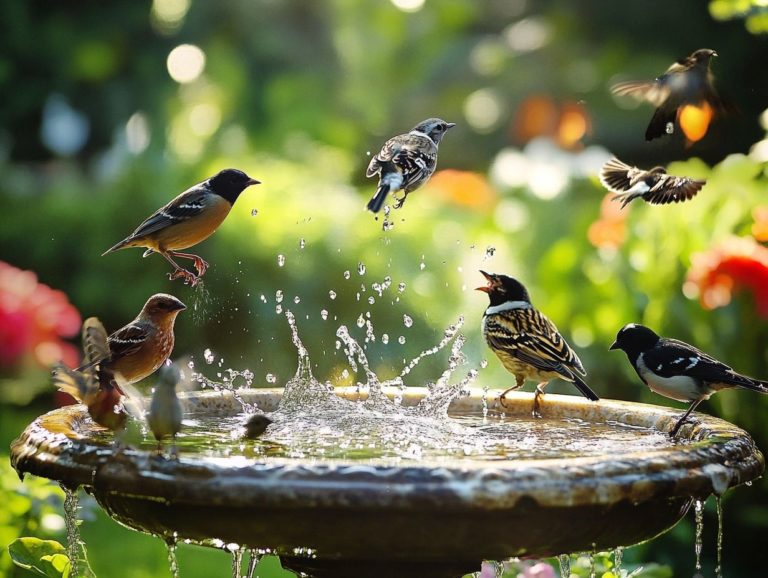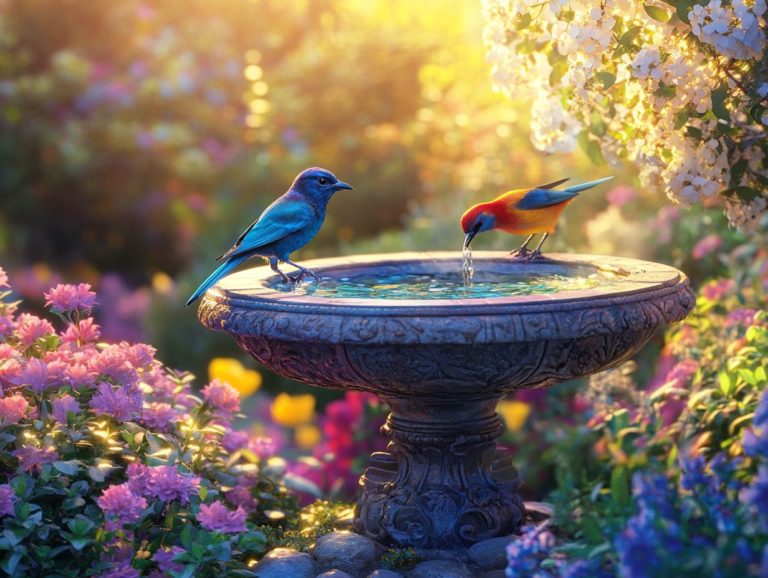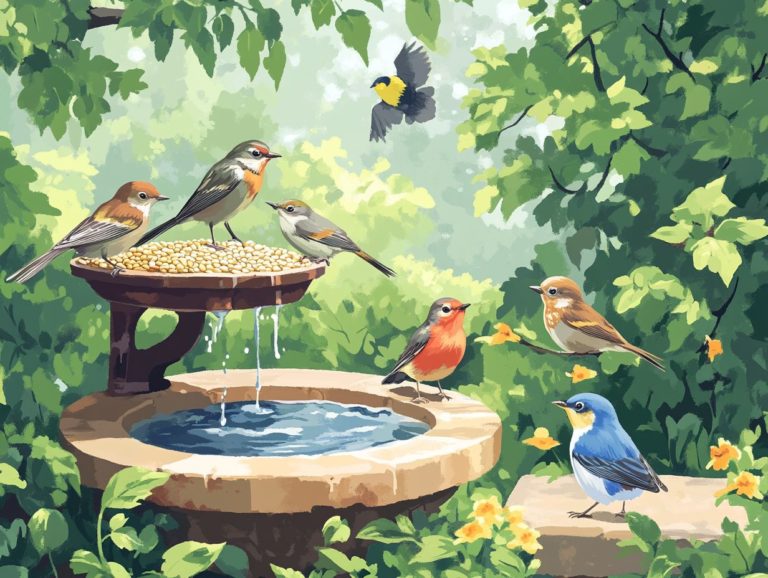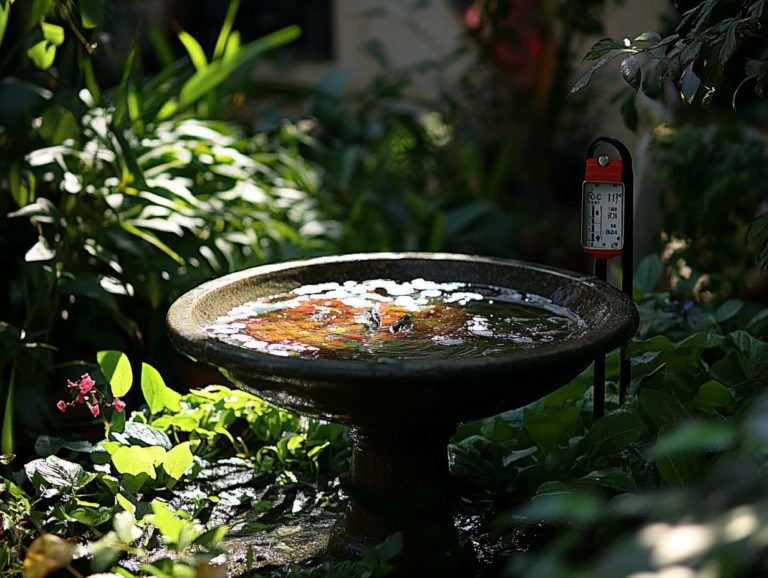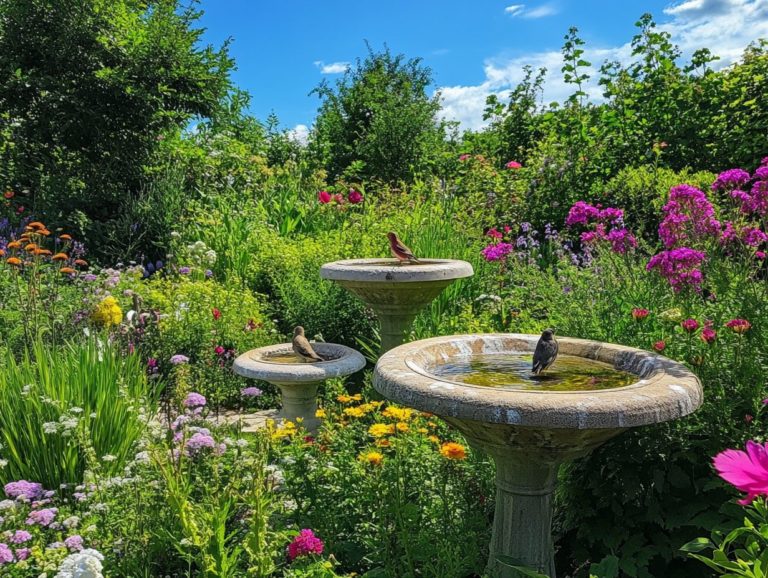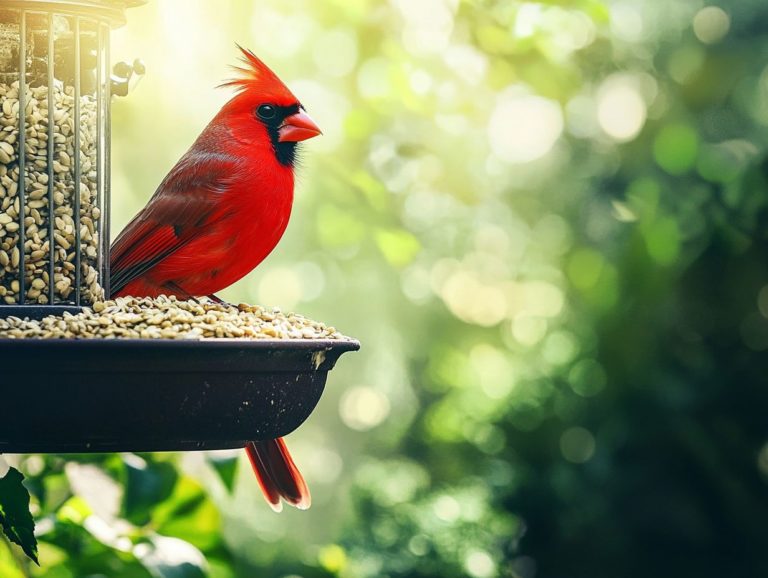The Best Times to Refill Your Bird Feeder
Keeping your bird feeder filled is essential for attracting a delightful variety of birds. Consider factors like weather, feeder location, and local bird populations to make refilling effective.
Before refilling, take into account essential factors such as weather conditions, the feeder’s location, and the bird population in your area. It’s vital to understand the optimal times for refilling and best practices for maintaining a healthy feeder.
Whether you’re an experienced birdwatcher or just starting this rewarding journey, you can create a haven for your feathered friends!
Contents
- Key Takeaways:
- Factors to Consider Before Refilling Your Bird Feeder
- Best Times to Refill Your Bird Feeder
- How to Properly Refill Your Bird Feeder
- Tips for Maintaining a Healthy Bird Feeder
- Frequently Asked Questions
- What are the best times to refill your bird feeder, including considerations for bird strike prevention?
- Should I refill my bird feeder every day?
- Is there a specific time of day that birds prefer to eat from a feeder?
- What happens if I don’t refill my bird feeder regularly?
- Are there any times when I shouldn’t refill my bird feeder?
- How can I tell if my bird feeder needs to be refilled?
Key Takeaways:
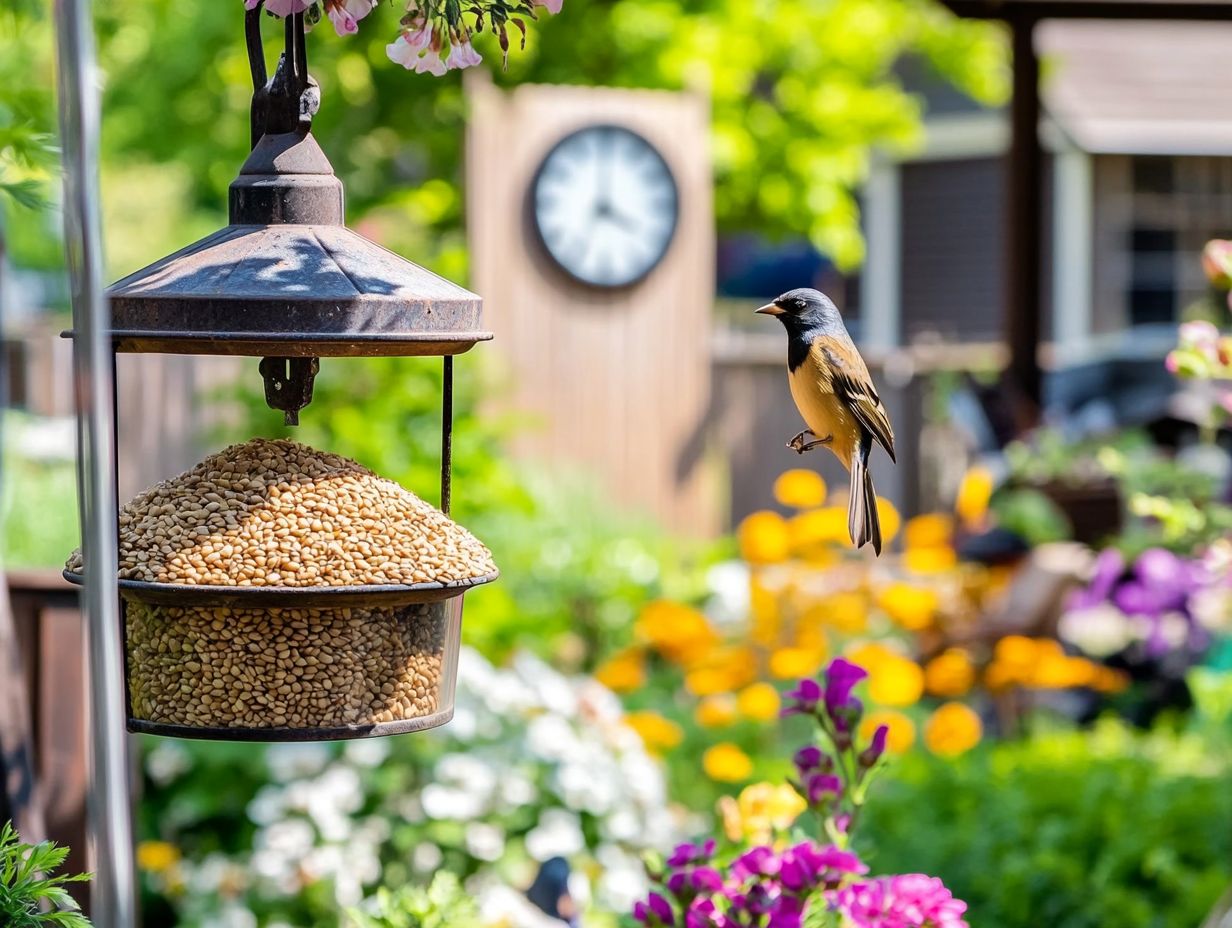
- Refill your bird feeder when weather conditions are favorable and not too extreme to ensure the safety and comfort of your feathered friends.
- Consider the location of your feeder and the bird population in your area when determining the best time to refill.
- Regularly clean and sanitize your feeder and choose the right type of food to maintain a healthy environment for birds.
Why is it Important to Refill Your Bird Feeder?
Refilling your bird feeder is crucial for keeping your backyard vibrant and lively. It supports the dietary needs of various backyard birds while enhancing your birdwatching experience.
A well-fed bird community not only contributes to a thriving wildlife habitat but also attracts diverse species that depend on feeders as a reliable food source.
By understanding the significance of timely refills, you can prevent seed spoilage and promote the health of the birds visiting your feeder, ensuring your backyard remains a sanctuary for these beautiful creatures.
Regularly replenishing the feeder with an assortment of foods like seeds, nuts, and suet ensures that different bird species find what they need to flourish. Providing fresh, clean water is equally essential, as hydration is vital for their overall health and can greatly influence their feeding behaviors.
Diligently refilling establishes a consistent feeding environment that reduces competition among birds and minimizes the risk of bird diseases that may arise from overcrowding or spoiled food.
Maintaining this routine allows you to witness captivating interactions and a broader array of species, amplifying the joy of observing nature in its purest form.
Factors to Consider Before Refilling Your Bird Feeder
When considering the best practices for bird feeding, several key factors determine the optimal timing and method for refilling your bird feeder. This ensures that you meet the unique needs of the birds visiting your backyard.
By understanding the local bird population and their seasonal movements, you can tailor your feeding strategies to align with their requirements. Placing your feeders in the right locations enhances accessibility and attracts a wider variety of birds.
This not only enriches your feeding experience but also promotes the overall health of the bird species in your area.
Weather Conditions
Weather conditions are a vital consideration when refilling your bird feeder. Extreme temperatures and precipitation can greatly affect the availability of natural food sources and the feeding behaviors of birds.
Take winter, for instance: Your backyard birds may depend on feeders more heavily due to a scarcity of food. This makes it essential to provide quality seeds, such as sunflower and millet, along with clean water to ensure their survival.
Understanding how different weather patterns influence bird feeding habits allows you to adopt more effective and responsible feeding practices.
During harsh weather, especially when snow blankets the ground or rain washes away seeds, birds benefit significantly from a consistent food supply. This not only meets their nutritional needs but also encourages regular visits to your feeders.
In winter, clean water sources become invaluable when natural ones freeze over. Keeping your bird baths filled with fresh water is crucial for their care.
Safeguarding feed from spoilage is crucial. Opting for airtight storage containers can prevent mold and protect against bird diseases, which can spread rapidly in less-than-ideal feeding conditions.
Feeder Location
The location of your bird feeder is crucial for attracting a diverse array of backyard birds. A well-placed feeder enhances your birdwatching experience by creating a welcoming habitat for wildlife.
When choosing spots, consider areas that offer both shelter and visibility. This makes birds feel safe and allows you to easily observe their fascinating behaviors. Surrounding your feeder with native plants can increase food availability, turning your feeder into a favorite destination for hungry visitors.
Positioning feeders near windows or seating areas boosts your chances of witnessing vibrant feeding frenzies. These thoughtful placements can transform your backyard into a lively ecosystem, supporting bird life while providing you with endless opportunities to connect with nature.
Bird Population in Your Area
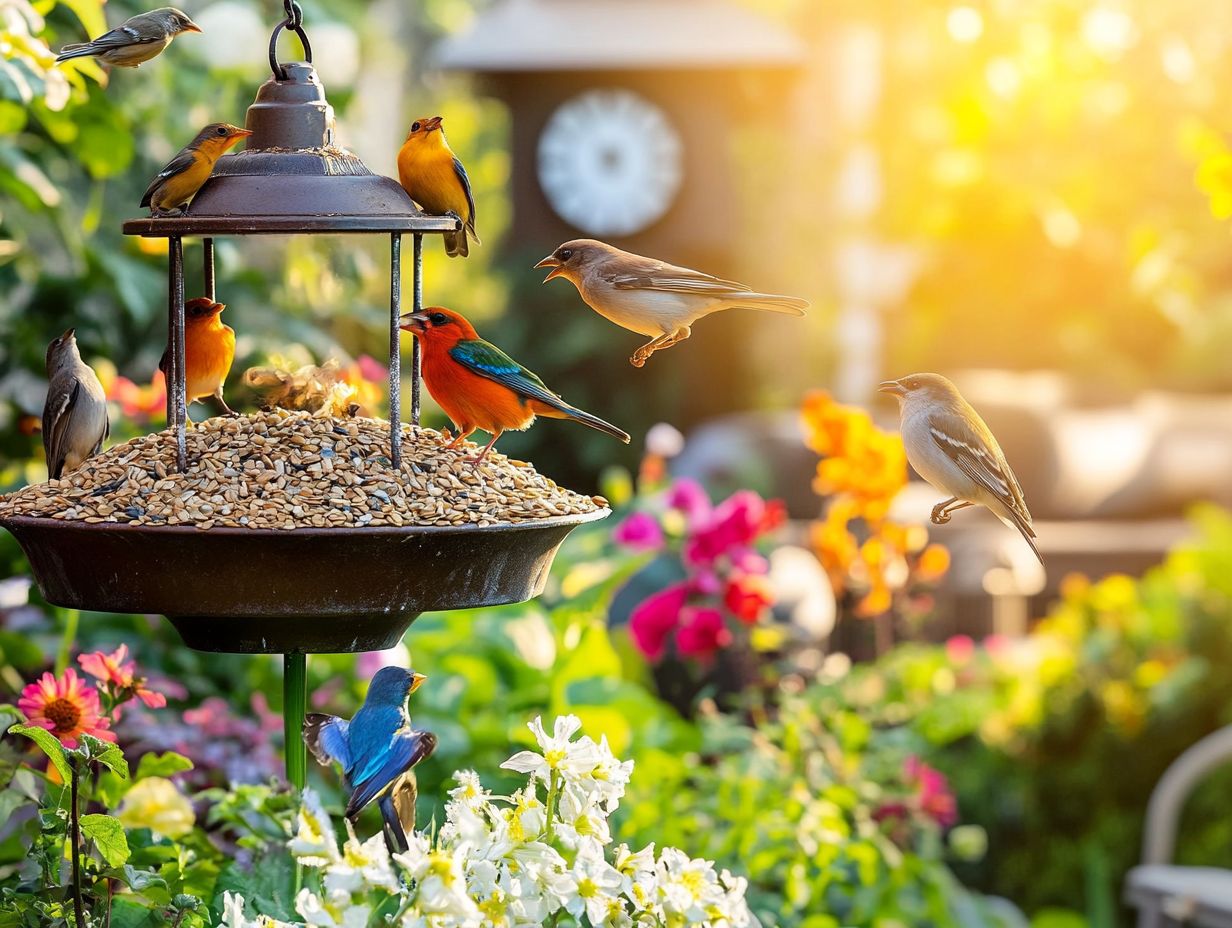
Understanding the bird population in your area is crucial for refining your bird feeding strategy. Different species have unique dietary preferences influenced by local food sources and migratory patterns. By observing which birds visit your backyard, you can select the most appropriate bird food and adjust your feeding schedules to meet their needs.
Being aware of local bird diseases will help you create a healthy feeding environment, ensuring your backyard remains a safe haven for all species.
To effectively identify and observe local bird populations, consider keeping a journal to log your sightings and their behaviors. Noting the arrival and departure times of certain species can unveil migratory patterns, helping you anticipate when to provide specific types of food.
Take into account the seasonal variability in local ecosystems, as this can influence the availability of natural food sources. By offering the right foods at the right times, you will attract a diverse array of birds and play a vital role in their nutrition and well-being.
Maintaining your feeders and birdbaths can significantly reduce the risk of disease outbreaks, fostering a thriving habitat for both resident and migratory birds.
Best Times to Refill Your Bird Feeder
Identifying the optimal times to refill your bird feeder is essential for crafting a feeding schedule that aligns with the natural rhythms of backyard birds. By closely observing feeding patterns of species like hummingbirds and goldfinches, you can determine whether morning or evening refills yield better results.
A consistent refill schedule helps birds see your feeder as a reliable source of food, nurturing a delightful connection between you and the bird community.
Morning or Evening?
Deciding when to refill your bird feeder can make a big difference in attracting birds. Many birds, especially hummingbirds, are active at dawn. Refilling your feeder early ensures they find fresh food right when they arrive. However, refilling in the evening can also attract birds that feed at night and those that prefer a dusk dining experience.
During cooler morning hours, a flock of songbirds often gathers at feeders to stock up on energy for the day. By refilling the feeder just before dawn, you ensure that fresh seeds or nectar are ready for their arrival. Conversely, topping off feeders in the late afternoon can draw in evening visitors like sparrows and cardinals that emerge as the sun begins to dip.
Paying attention to feeding patterns can unveil peak times; if you notice a drop in activity, adjusting your refill schedule to align with their preferences can enhance the overall feeding experience. By customizing your approach, you create a welcoming environment that attracts a diverse array of birds throughout the day.
Frequency of Refilling
Establishing the right frequency for refilling your bird feeder is essential for transforming your backyard into a birdwatching paradise. Regular refills provide a steady food source, helping to prevent seed spoilage and mold growth that can lead to avian diseases. By closely monitoring feeder activity, you can determine the best times to refill that cater to the birds’ needs while minimizing waste.
To effectively assess feeder activity, observe how quickly the birds consume the seeds and take note of the types of birds visiting. A bustling feeder may require more frequent refills, especially during peak migration seasons. It’s also prudent to check the feeder regularly for any uneaten seeds, as stale offerings can deter birds and encourage spoilage.
Best practices include:
- Storing seeds in a cool, dry place is crucial for proper bird food safety to keep our feathered friends healthy.
- Using airtight containers to maintain freshness is one of the essential bird feeding tips for preventing seed spoilage.
- Cleaning the feeder every few weeks is necessary.
These steps will help deter unwanted pests, including cats, and ensure that the seeds you provide are both safe and appealing, contributing to a healthy wildlife habitat.
How to Properly Refill Your Bird Feeder
Properly refilling your bird feeder is crucial for fostering a thriving feeding environment, ensuring that the backyard birds receive the essential nutrients they need. Start your journey by choosing the right types of bird food while prioritizing food safety.
Opt for high-quality seeds or food think sunflower seeds and millet for a variety of birds, or nectar for hummingbirds. Adopt a systematic approach to filling the feeder; this not only elevates the feeding experience but also mitigates risks linked to avian diseases and spoilage.
Your commitment will transform your backyard into a sanctuary for our feathered friends.
Step-by-Step Instructions
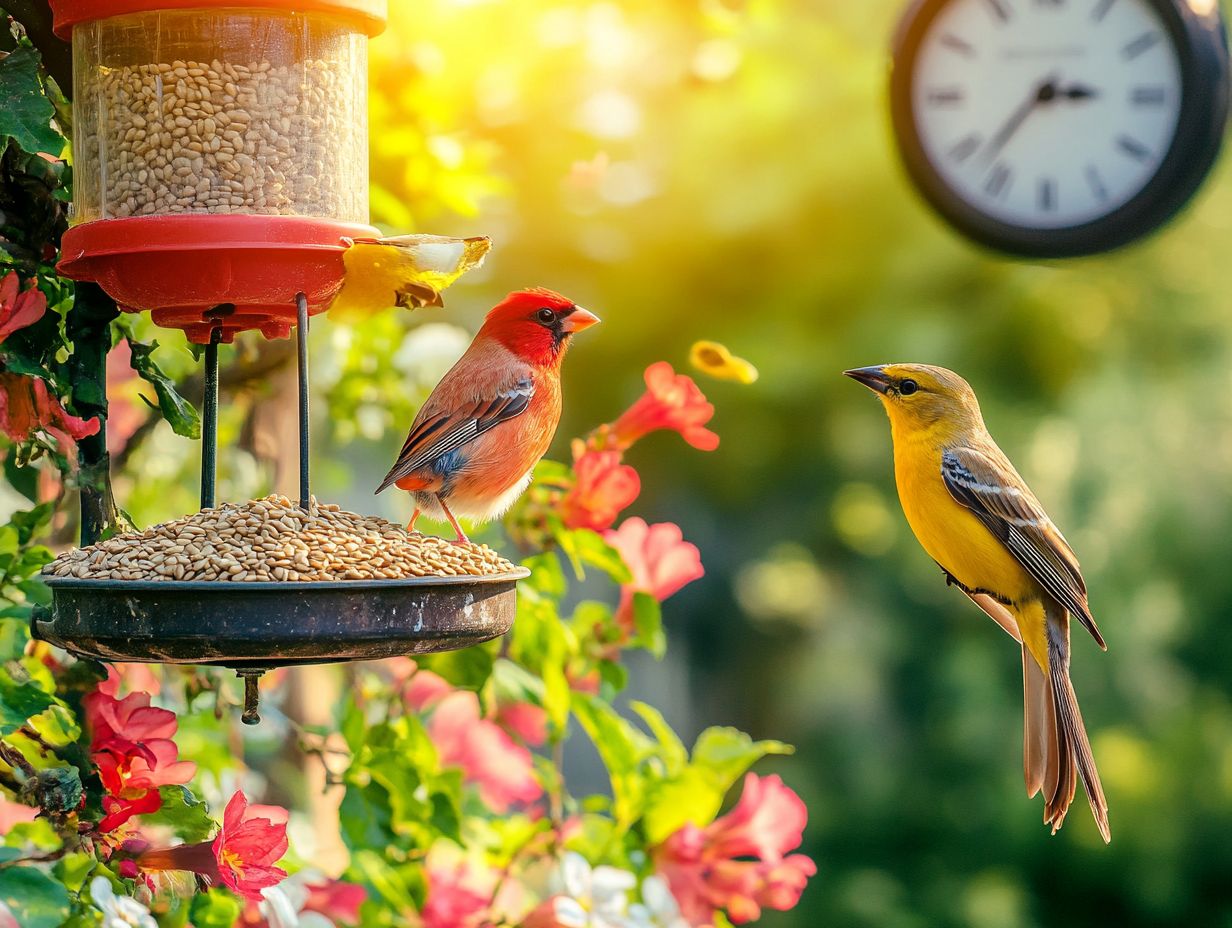
To ensure a successful refilling of your bird feeder, follow these detailed instructions that prioritize both bird food safety and the well-being of your feathered visitors. Start by giving your feeder a thorough cleaning to prevent the spread of avian diseases. Ensure it s free from mold and spoiled seeds to keep your feathered friends coming back!
Next, select the appropriate types of bird food based on the species in your area, filling the feeder with care. Avoid overfilling, as this can lead to waste and spoilage.
Once you’ve chosen the right food, use optimal filling techniques by gently tapping the feeder to settle the seeds. This will create a snug fit without causing overflow. It s also crucial to regularly inspect the feeder for any signs of contamination or mold, which can pose serious health risks to birds.
Keeping your feeder clean is essential; wash it with hot, soapy water or a vinegar solution at least once a month to maintain its condition.
This routine not only safeguards the health of the birds but also encourages more frequent visits, ultimately enriching your backyard experience.
Tips for Maintaining a Healthy Bird Feeder
Maintaining a healthy bird feeder is essential for safeguarding the safety and well-being of the beautiful birds that grace your backyard. Regular cleaning and sanitizing practices are vital to prevent avian disease from spreading.
By routinely inspecting your feeder for seed spoilage and following best practices for bird food safety, you can greatly diminish the chances of avian diseases spreading among your feathered companions.
Embracing these maintenance tips within your bird feeding routine will not only foster a welcoming environment for diverse wildlife but also elevate your overall birdwatching experience to new heights.
Cleaning and Sanitizing
Cleaning and sanitizing your bird feeders is crucial. This practice maintains a safe haven for the feathered visitors, especially during winter bird feeding seasons.
Start by disassembling the feeder and washing each component with a mild soap solution. Rinse thoroughly with clean water to eliminate any soap residue. For an extra layer of safety, soak the feeder in water mixed with a little bleach for about 10 minutes before rinsing once more. This ensures every surface is free from mold, bacteria, and spoiled seeds. This step is particularly critical for feeders that will be used during seasonal feeding times.
After cleaning, let the feeder air dry completely in a sunny spot. Sunlight acts as a natural germ eliminator and can help attract wildlife to your garden. Don’t forget to tidy up the area around the feeder by removing any discarded seed hulls, droppings, or debris, as these can be breeding grounds for diseases.
Clean your feeder weekly during peak times like spring and summer. In autumn and winter, monthly cleanings may suffice. By dedicating yourself to this hygienic practice, you’ll significantly reduce the risk of disease transmission among birds, fostering a healthier environment for them to thrive.
Choosing the Right Type of Food
Choosing the right food for your bird feeder is crucial. This helps attract a diverse array of backyard birds and meets their health needs. For instance, if you want to please hummingbirds, specialized hummingbird food is the way to go. Goldfinches, on the other hand, particularly enjoy sunflower seeds and nectar.
Different species have their own unique dietary requirements. It’s essential to offer a range of food options. While seed blends can appeal to many birds, suet serves as an excellent energy source for winter bird feeding, especially for woodpeckers and other winter visitors. Incorporating natural food sources, like native plants and flowers, provides a sustainable option for birds while supporting the environment.
Seasonal changes can affect food availability. Adjusting your feeding strategy can enhance visits from migratory species during spring and fall. By being mindful of these factors, you elevate both the feeding experience and the ecological balance in your backyard, contributing to a richer birdwatching enjoyment.
Feeder placements are also important for attracting various species, particularly during migratory patterns.
Frequently Asked Questions
What are the best times to refill your bird feeder, including considerations for bird strike prevention?
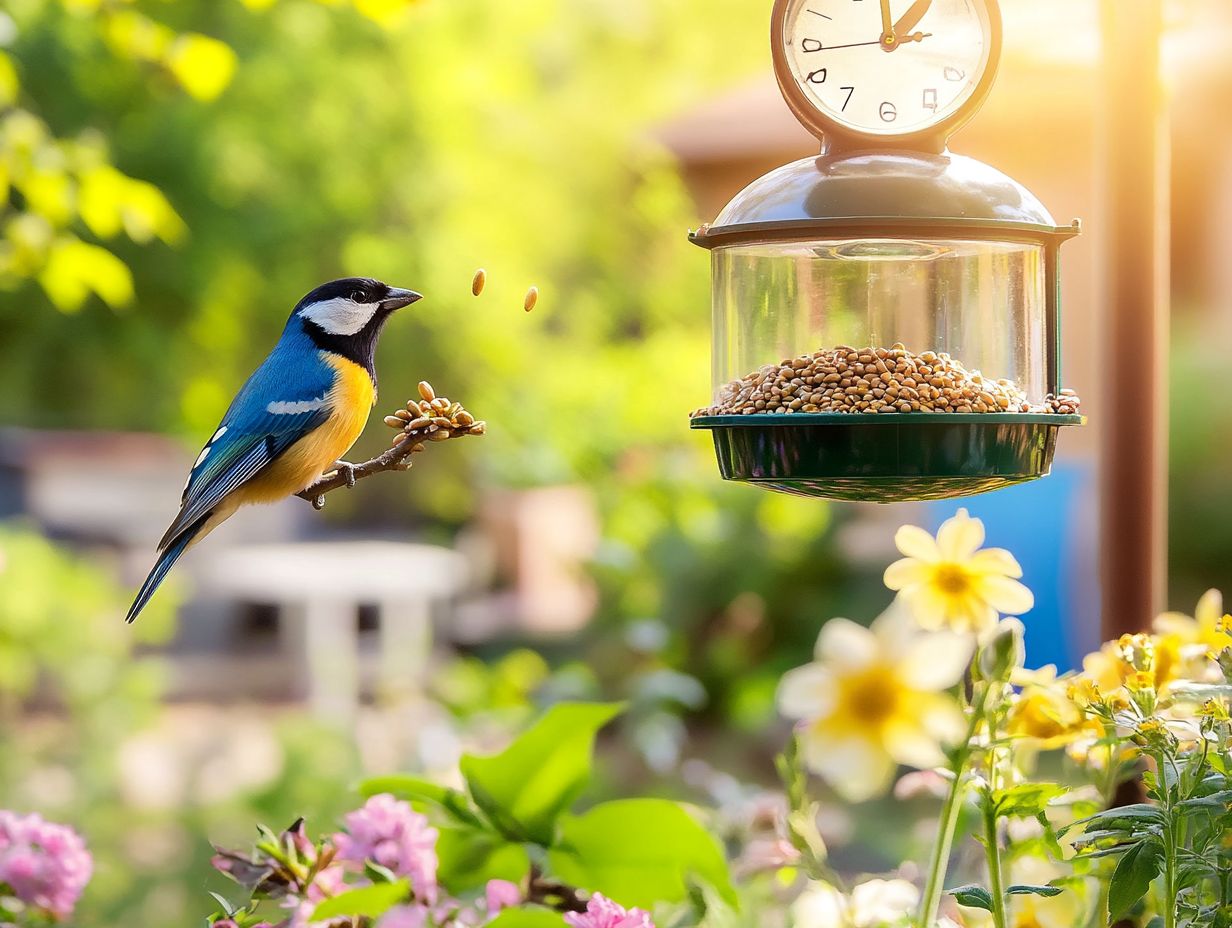
The best times to refill your bird feeder are early in the morning and late in the afternoon. This is when birds are most active and searching for food.
Should I refill my bird feeder every day?
It is not necessary to refill your bird feeder every day. The frequency of refilling depends on the number of birds visiting your feeder and the amount of food they consume.
Is there a specific time of day that birds prefer to eat from a feeder?
Not all birds have the same feeding habits. In general, birds prefer to eat from a feeder during the early morning and late afternoon. Some species may also visit the feeder throughout the day.
What happens if I don’t refill my bird feeder regularly?
If you do not refill your bird feeder regularly, the birds, including goldfinches and hummingbirds, may lose interest and stop visiting. Maintaining a consistent schedule for refilling is important to keep the birds coming back.
Are there any times when I shouldn’t refill my bird feeder?
It is not recommended to refill your bird feeder during heavy rain or strong winds. This can cause the food to spoil quickly, impact clean water access, and make it difficult for birds to access the feeder.
How can I tell if my bird feeder needs to be refilled?
You can tell if your bird feeder needs a refill by watching the birds. If they keep arriving but find no food, it s time to restock.
Check the food level in the feeder. Make sure to provide clean water for the birds.

